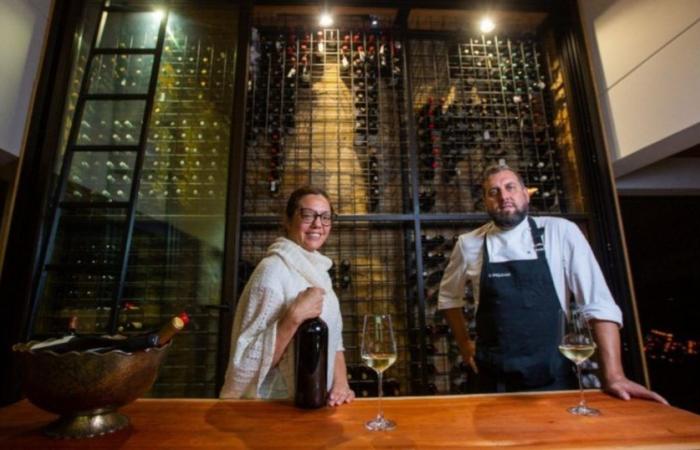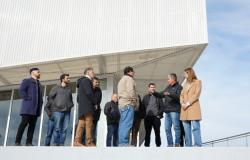Gabriela Lafuente He speaks with great passion about wine, gastronomy and tourism, but he also puts an analytical focus. He maintains that Salta must improve infrastructure to attract a wine consumer with greater purchasing power. Gabriela is a sommelier at El Baqueano Salta, a true house of contemporary native cuisine. The sommelier will be part of the panel that this afternoon will present her andn the Convention Center, from 6 p.m..
How do you analyze the evolution of wine tourism in Salta?
Well, I believe that wine tourism is a path that began a long time ago and that remained as a medium on “stand-by” in Cafayate, specifically. The other wine regions continued to develop and make more investments for other types of audiences. In the last year, wineries have begun to give importance to that part again. It doesn’t mean that there isn’t wine tourism, but there are times when you let the structure go, when you stop providing five-star services, you lose a consumer who likes it and looks for that type of service. Today wine tourism in Mendoza has values in dollars and they are full all the time. In terms of infrastructure, Cafayate has begun to do several things and renew itself in the last year. Although the Grace has always been a hotel, the other hotels have begun a change and it is the same thing that also happens in the city of Salta. Since the direct San Pablo – Salta flight was opened, the Sao Paulo native above all is a great connoisseur of the world of international wine. Although this is not a primarily wine region and they do not have large production, they are large consumers.
I worked in San Pablo, that is, I know and travel a lot to San Pablo representing the wine of Argentina and I am always talking about the Calchaquí Valleys region, the high-altitude wines… Since the flight opened, a lot of people have come, but the luxury infrastructure is still missing, which is what they like.
The São Paulo native is a person who has a lot of money, who likes to invest, as they say, in the “bon vivant” and Cafayate still seems to be lacking. Little by little things are opening up, but up until 3-4 years ago it was kind of just sitting on its hands. It’s like an investment was made and that’s it.
Is this infrastructure that you mention more amenities or does it depend on building conditions?
Yes, the lodging conditions, the type of amenities that the place provides, the services it provides, it is a different type of public. Maybe in the last year there has been a huge change, I see it, I go to the valley quite a few times a year. I am in contact with all the winemakers, it was essential for me, not only since we decided to move El Baqueano to Salta. I have been going to the valley since 2009, I went two or three times a year, for my profession. I always liked it, because I believed that it was a region that had yet to be exploited and above all we were marked on a line of wines, a style of wines of an older consumer and it was not modernized… And that has also changed in the last five or six years in the Calchaquí Valley and the valley’s winemakers. And it is something that I talk a lot with them too, the style of northern wine has changed a little to wines that are easier to drink in their tannins, easier to understand, more gastronomic as well. There has been a lot of supply of whites. Since I knew that El Baqueano was going to come to Salta, I have driven them crazy with the topic of whites, because in a harmony of wines, in a tasting menu, whites are the ones that are drunk the most.
In my pairing there is only one red. So everyone else is white, there is a diversity of white people in the valley, every day there are more exponents.
In the Calchaquí Valley they have something, that they are very collaborative among themselves when it comes to the growth of the region and wine tourism is a fundamental tool, you just have to take into account the type of services you provide, the communication you provide and always aim whoever has it, who is the one who is going to come and leave his dollars or whatever in the region.
With traditional wines, it was clearer what the association was in the pairing. From the most basic, by color… but what was the challenge with the El Baqueano kitchen of finding the right wine?
In Buenos Aires, although we were there, we made a menu that covered all the ecoregions of Argentina, we always had a lot of products from the NOA in general, because it is the most productive region in the calendar year, because it is the most biodiverse region. That’s why El Baqueano moves north. Salta is the heart of the NOA and that was the decision to have moved the restaurant to this particular place, to this region, because there is a lot of product diversity throughout the year. So it’s not that we arrived and didn’t know the products or the producers, we have been doing a job for 16 years, we work very directly with the producer. Now we have no carbon footprint.
If I wanted to have offers on white wines from Salta, because white wines are the ones that find agreements, everywhere, it is not just here. All over the world, pairings are 90% white, 15-10% red, because the tannins do not agree with food, in most cases. Blindly, I can give you a medium-rare steak and it goes better with an oaky Chardonnay than with a red. There are myths that are created behind the colors of wines or that fish goes with white and meat goes with red, no. It will depend on many other things, it depends on the sauce, the accompaniments, the nuances that that dish may have, if they are acidic, if they are spicy, if they are very spicy. So white usually makes more harmony with all dishes. At El Baqueano in Buenos Aires I used whites from all over the country, when I had to come here, our pairing was 100% Salta, the idea is that you can tour the entire province in one experience, one night. In that search work I drove the winemakers crazy too and every day they are getting more and have more options. Today I have wines from all the producers in the province.
And high-altitude wine, what pairs best with?
First, I call them more harmonies than pairings, because pairings are never good.
Tell me a little about that concept.
Marriage is generally never something exact, so I always talk about a harmony between a dish and a wine. I use the word harmony more than pairing and in itself it does not matter where the wine comes from, but it is the style that marks the wine and the dish has a lot of nuances that can go with or not with that style, bringing out the colors, bringing out all. A high-altitude wine has as its own peculiarity an acidity, depending on how they make it, a much fresher and higher acidity than a wine from a lower region.
Speaking in general particulars, acidity is always a good driver at the time of a meal, because when there is acidity in a dish, you salivate, then it is generating a lot of combinations with respect to what the dish is, what the wine is, It doesn’t matter if it is of maximum height or not, but we do have to see many conditions, what the soil is like, how they did it, what intervention it had, how its fermentation was; whether the yeasts are indigenous or selected. That changes a lot. The work of the winemaker will depend on what the weather was like that year, in that particular place.
We in the Valley have many microclimates, so the altitude also has the benefit of allowing the vine to rest, it also generates many microclimates, it depends on where they are. There is a lot of work to do, not only in making wines, but in communicating. I consider that the Calchaquí Valley, the high altitude wines, is the oldest region in Argentina and is the least communicated.






